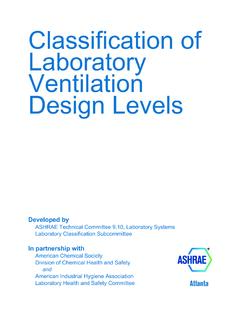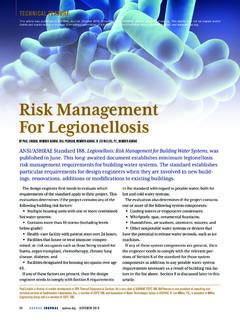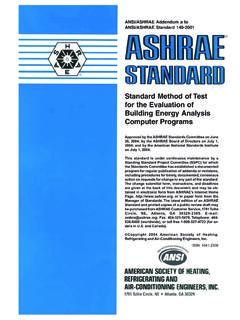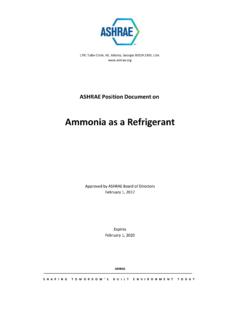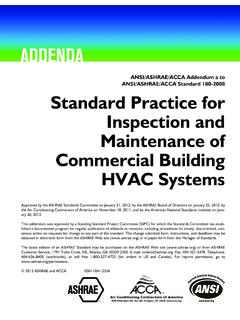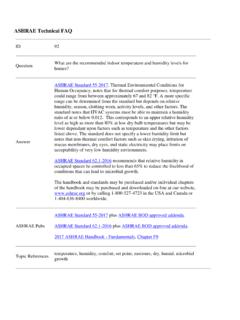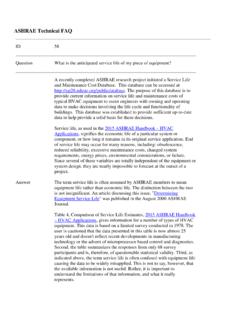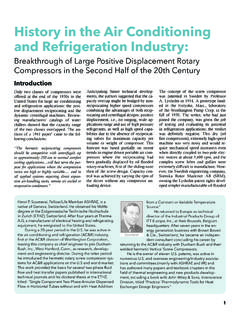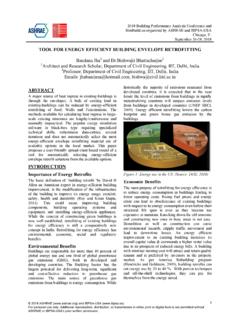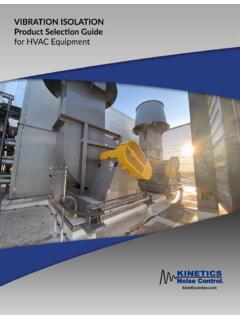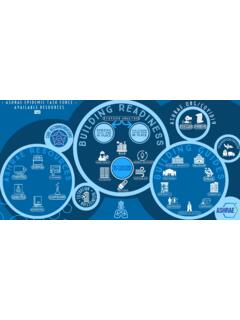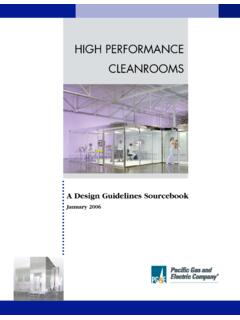Transcription of ASHRAE EPIDEMIC TASK FORCE
1 ASHRAE EPIDEMIC TASK FORCE . SCHOOLS & UNIVERSITIES | Updated 5-14-2021. Introduction New/Modified Facility Design Recommendations ASHRAE ETF Core Recommendations Introduction Background and General Recommendations Designer Guidelines General School General Operations References Nurses Office General Requirements Determining Building Readiness Checklist for Unoccupied Buildings Filtration Upgrades Startup Checklist for HVAC Systems Prior to Occupancy Introduction Filtration Basics Filtration Target Level Filtration Upgrades: Information Gathering Stage Equipment & System Specific Checks & Verifications During Academic Year Filtration Upgrades: Data Analysis & Review Cleaning & Air Flush Filtration Upgrades: Implementation & Considerations Boilers Chilled, Hot & Condenser Water Systems Operation of Occupied Facilities Air Cooled Chillers Controlling Infection Outbreak in School Facilities Water Cooled Chillers Cooling Towers & Evaporative-Cooled Devices Higher Education Facilities Steam Distribution Systems Student Health Facilities HVAC Water Distribution Systems Laboratories Pumps Athletic Facilities Air Handling Units Residence Facilities Roof Top Units Large Assembly Unitary & Single Zone Equipment Disclaimer QUESTIONS?
2 Introduction Protecting the health, safety and welfare of the world's students from the spread of SARS-Cov-2 (the virus that causes COVID-19 disease) is essential to protecting the health, safety and welfare of the entire population. ASHRAE 's position is that Transmission of SARS-CoV-2 is significant and should be controlled. Changes to building operations, including the operation of heating, ventilating, and air-conditioning [HVAC] systems, can reduce airborne exposures.. There is broad variation of complexity, flexibility, and age in HVAC equipment, systems, controls and Building Automation Systems (BAS) in educational facilities. This guidance has been formulated to help designers retrofit and plan for the improvement of indoor air quality and to slow the transmission of viruses via the HVAC systems.
3 The underlying effort of the designer should be to mitigate risk of airborne pathogen transmission through a combination of strategies, including increased ventilation, better filtration, improved air distribution, or use of other air cleaning or treatment technologies. Control options should be selected to provide desired exposure reduction while minimizing associated energy penalties. The designer should also be concerned with maintaining indoor comfort as defined by the design temperature and relative humidity. This guidance should be applied to each unique climate zone, unique school building and HVAC system. All retrofits and modifications must not contradict ASHRAE guidelines and must continue to meet or exceed the standards and codes adopted by local jurisdictions.
4 The designer needs to work closely with the local school system to work in conjunction with new operational protocols and school operations. The following is meant to provide practical information and checklists to school district and university campus environmental health managers, facility managers, administrators, technicians, and service providers to prepare educational buildings to resume occupancy. This information describes how the HVAC systems should be operating to help minimize the chance of spreading SARS-Cov-2 and how to practically check/verify that operation. EPIDEMIC Task FORCE Core Recommendations ASHRAE Core Recommendations for Reducing Airborne Infectious Aerosol Exposure are available HERE. Background and General Recommendations Applicability and Limitations The focus of this guidance is to mitigate the potential for transmission of the SARS-CoV-2 virus through HVAC systems and to reduce concentrations of infectious aerosols present in occupied spaces to the extent possible.
5 It should be clearly stated and understood that adherence to this guidance does not eliminate the potential for airborne transmission of the virus and should not serve as a replacement for other steps such as social distancing, use of masks or other face coverings, cleaning and disinfection of surfaces, etc. This guidance is primarily focused on HVAC systems within school and higher education facilities many organizations are likely to have challenges outside of these facilities as well transportation systems (primarily buses) may be an area of specific concern Refer to the ASHRAE EPIDEMIC Task FORCE Transportation Guidance for additional information General Operations References Guidance from cognizant authorities should be followed to the extent possible.
6 Select guidance that is likely applicable for educational facilities includes: United States CDC Readiness and Planning Tool to Prevent the Spread of COVID-19 in K-12 Schools. o This reference provides recommendations for policies, general operations, response protocols, communications, etc. United States CDC Guidance for K-12 School Administrators on the Use of Cloth Face Coverings in Schools and Additional Considerations Table. o These documents provide guidance for K-12 facilities in the use of cloth face coverings. United States CDC Considerations for Institutions of Higher Education. o This reference provides general information, risk assessment guidance, and recommendations for higher education institutions. United States CDC Guidance for Cleaning and Disinfecting.
7 O This reference provides cleaning guidance for multiple building types and should be applicable to most K-12 and higher education spaces. WHO Advice on the use of masks in the context of COVID-19. o Background for recommendations associated with masks or face coverings and recommendations for use under different circumstances. Harvard Chan School of Public Health Schools For Health o Risk reduction strategies, guide to checking ventilation, classroom calculators. Guidance from individual states or territories (United States): Johns Hopkins University eSchool+ Initiative Analysis of Reopening Plans. o This reference includes basic information on state K-12 reopening plans and links to information from individual states where specific guidance and requirements can be located.
8 Determining Building Readiness and Operations for Existing Facilities to Reoccupy After Shut-Down due to Pandemic These recommendations and strategies are organized in order from simple first steps, more involved next steps and then more long-term improvements 1. Create a District or Campus Health and Safety Committee that includes all stakeholders (environmental health and safety, administration, education staff, operations staff, local healthcare providers, etc.). 2. Develop policies for staff and contractor PPE requirements for completing work at facilities that follow local authority, CDC, and OSHA guidelines for the proper use of Personal Protective Equipment (PPE). 3. Where semi-annual / annual scheduled maintenance on the equipment can be performed safely, do not defer this maintenance cycle.
9 4. Where worker safety could be at risk, defer semi-annual/ annual maintenance on the equipment up to 60. days until worker safety can be accomplished. 5. During the summer period before occupancy perform Checklist No. 1 Summer Checklist for Fall Start of Classes. 6. Operate all HVAC in occupied mode for following minimum periods prior to resuming full occupancy: 1. Any time staff or others are in the building. 2. 24 hours if systems have operated during closure period. 3. Up to one week prior to occupancy if systems have been shut down to bring temperature and humidity under control prior to occupancy. 7. During the week prior to occupancy perform Checklist No. 2 Startup Checklist for HVAC Systems Prior to Occupancy. Checklist No. 1: Checklist for Unoccupied Buildings Prior to Occupying: Review design guidance for potential system modifications to comply with this guidance.
10 Review air distribution conditions of existing spaces (look for covered diffusers, blocked return grilles, overly closed supply diffusers/registers and return/exhaust grilles creating short cycling, possible measurements of airflows by commissioning or balancing professionals, possible review of overall system configuration by design professional, etc.). Review existing Indoor Air Quality issues, if any, records of documents and investigate current status of complaint and address any deficiencies identified, if possible. General inspection of spaces to identify any potential concerns for water leaks or mold growth that could negatively impact occupant health. Check all lavatories and sinks for correct operation and ensure soap dispensers are functional and adequate supply of soap is available to allow for proper handwashing.
